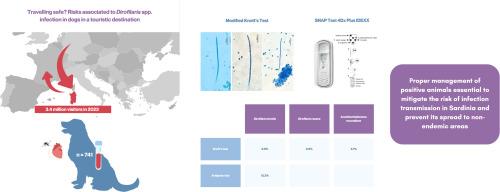Travelling safe? Risks associated to Dirofilaria spp. infection in dogs in a tourist destination
IF 1.7
Q3 PARASITOLOGY
Current research in parasitology & vector-borne diseases
Pub Date : 2025-01-01
DOI:10.1016/j.crpvbd.2025.100298
引用次数: 0
Abstract
Dirofilaria immitis and Dirofilaria repens, the causative agents of canine heartworm disease and subcutaneous dirofilariosis, respectively, are the most studied filarioid species, given their veterinary and public health significance. Considering the environmental conditions and the role of Sardinia as a tourist destination, a study was conducted on 741 dogs to update the prevalence and the risk factors of these infections. For each animal, information regarding biological and management parameters was collected. All enrolled dogs were older than 12 months and had no macrocyclic lactones treatments in the previous year. Blood samples were obtained and analyzed by modified Knott’s test and ELISA rapid test (SNAP 4DX, IDEXX). An overall microfilaremia prevalence of 15.2% was observed; D. immitis was the most prevalent species (9.9%), followed by D. repens (5.5%), while Acanthocheilonema reconditum microfilariae were identified in 3.1% of the samples. Dirofilaria immitis antigens were detected in 12.2% of the dogs included in the study. Dirofilaria immitis infection risk was statistically significant, considering the absence of ectoparasite treatments (χ2 = 21.863, P < 0.001), shelter housing (χ2 = 6.512, P = 0.011) and residence areas (χ2 = 64.725, P < 0.001). Dirofilaria repens infection risk was significantly higher in male dogs (χ2 = 4.904, P = 0.027), along with small-sized dogs (χ2 = 5.450, P = 0.020). This study confirms that dirofilariosis remains endemic across Sardinia, emphasizing the need for integrated control strategies to reduce the risk of infection spreading, protecting both animal and human health.

旅行安全吗?旅游目的地犬类感染滴丝虫的相关风险
鉴于其兽医和公共卫生意义,分别作为犬心丝虫病和皮下Dirofilaria repens的病原体,Dirofilaria immimitis和Dirofilaria repens是研究最多的丝虫种。考虑到环境条件和撒丁岛作为旅游目的地的作用,对741只狗进行了研究,以更新这些感染的流行率和危险因素。对每只动物收集有关生物学和管理参数的信息。所有入选的狗都大于12个月,在前一年没有接受过大环内酯治疗。采集血样,采用改良Knott试验和ELISA快速试验(SNAP 4DX, IDEXX)进行分析。微丝虫病总患病率为15.2%;其中,最常见的是粗纹弓形虫(9.9%),其次是粗纹弓形虫(5.5%),而细纹弓形虫占3.1%。在研究中,12.2%的狗检测到免疫双丝虫抗原。考虑到未进行体外寄生虫治疗,免疫丝虫感染风险有统计学意义(χ2 = 21.863, P <;0.001)、避难住房(χ2 = 6.512, P = 0.011)和居住面积(χ2 = 64.725, P <;0.001)。雄性犬和小型犬感染双丝虫的风险均显著高于雄性犬(χ2 = 4.904, P = 0.027)和小型犬(χ2 = 5.450, P = 0.020)。这项研究证实,撒丁岛各地仍然流行笛罗丝虫病,强调需要采取综合控制战略,以减少感染传播的风险,保护动物和人类健康。
本文章由计算机程序翻译,如有差异,请以英文原文为准。
求助全文
约1分钟内获得全文
求助全文

 求助内容:
求助内容: 应助结果提醒方式:
应助结果提醒方式:


